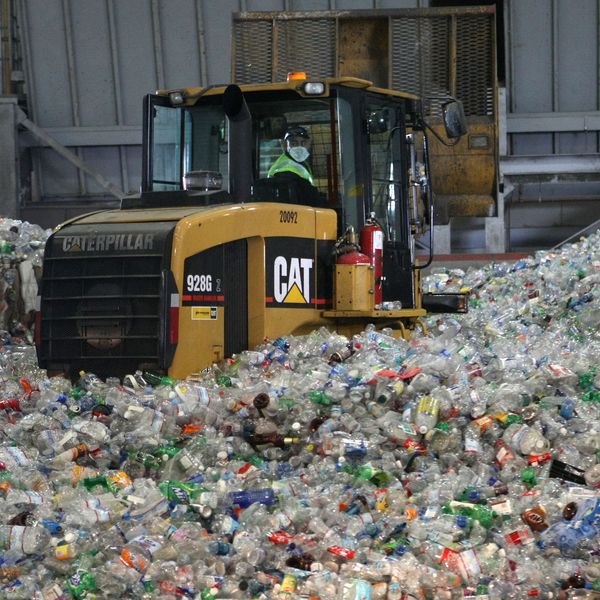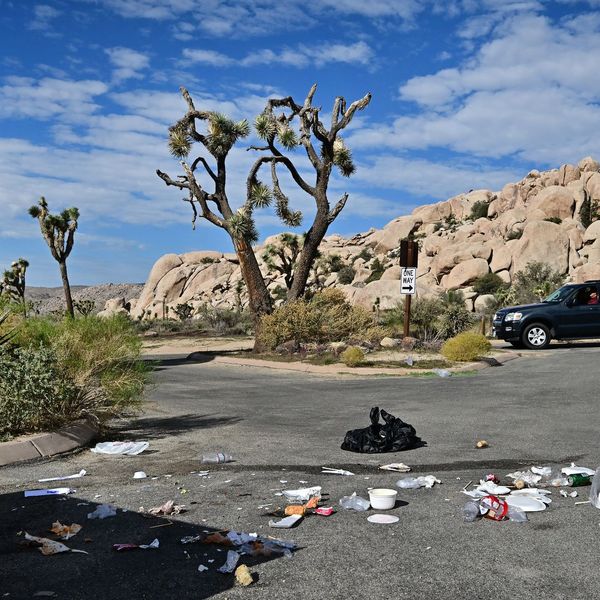Newly Discovered 'Plastic Island' Shows Global Epidemic Worsening
'Even if everyone stopped putting garbage in the ocean today, giant garbage patches would continue to grow for hundreds of years'

As new research by the 5 Gyres Institute shows, the existence of a new plastic island has been found swirling with junk in ocean currents running near Easter Island in the South Pacific, marking the first documented garbage patch in the Southern Hemisphere.
The new study, published in the journal Marine Pollution Bulletin, documents the first evidence of a defined oceanic "garbage patch," an accumulation zone of plastic pollution, floating in the area designated as the South Pacific subtropical gyre.
Conducting the first ever sampling of the southern gyre, the research team, led by 5 Gyres Institute Executive Director Dr. Marcus Eriksen, "recorded increased density of plastic pollution with an average of 26,898 particles per square kilometer, and a high of 396,342 km/m2 in the center of the predicted accumulation zone [based on ocean current models]."
"Without a doubt, we have discovered a previously unknown garbage patch in the South Pacific Subtropical Gyre," said Dr. Eriksen.
Also, a recent investigation by a team of Australia researchers found that "humans have put so much plastic into our planet's oceans that even if everyone in the world stopped putting garbage in the ocean today, giant garbage patches would continue to grow for hundreds of years." No matter where plastic garbage enters the ocean, the group said, it will inevitably end up in any of the five ocean basins.
These findings were the result of research done by the Australian Research Council Center of Excellence for Climate System Science who employed drifter buoys to determine how these giant ocean garbage patches form as a result of ocean currents.
"There are five known garbage patches in the subtropical oceans between each of the continents. Each contains so much plastic that if you were to drag a net through these areas you would pull up more plastic than biomass," said lead author Dr. Erik van Sebille.
The 1997 discovery of the 'Great Pacific Garbage Patch,' brought initial attention to the severe problem of plastic and plastic waste, particularly in how it affects our ocean ecosystems, but these findings show that "plastic pollution isn't just a North Pacific phenomenon but rather a global problem with global implications for fisheries, tourism, marine ecosystems and human health."
In the video below, Dr. Erik van Sebille discusses his research on oceanic plastic polllution with animations that illustrate the movement of plastic through the oceans:
An Urgent Message From Our Co-Founder
Dear Common Dreams reader, The U.S. is on a fast track to authoritarianism like nothing I've ever seen. Meanwhile, corporate news outlets are utterly capitulating to Trump, twisting their coverage to avoid drawing his ire while lining up to stuff cash in his pockets. That's why I believe that Common Dreams is doing the best and most consequential reporting that we've ever done. Our small but mighty team is a progressive reporting powerhouse, covering the news every day that the corporate media never will. Our mission has always been simple: To inform. To inspire. And to ignite change for the common good. Now here's the key piece that I want all our readers to understand: None of this would be possible without your financial support. That's not just some fundraising cliche. It's the absolute and literal truth. We don't accept corporate advertising and never will. We don't have a paywall because we don't think people should be blocked from critical news based on their ability to pay. Everything we do is funded by the donations of readers like you. Will you donate now to help power the nonprofit, independent reporting of Common Dreams? Thank you for being a vital member of our community. Together, we can keep independent journalism alive when it’s needed most. - Craig Brown, Co-founder |

As new research by the 5 Gyres Institute shows, the existence of a new plastic island has been found swirling with junk in ocean currents running near Easter Island in the South Pacific, marking the first documented garbage patch in the Southern Hemisphere.
The new study, published in the journal Marine Pollution Bulletin, documents the first evidence of a defined oceanic "garbage patch," an accumulation zone of plastic pollution, floating in the area designated as the South Pacific subtropical gyre.
Conducting the first ever sampling of the southern gyre, the research team, led by 5 Gyres Institute Executive Director Dr. Marcus Eriksen, "recorded increased density of plastic pollution with an average of 26,898 particles per square kilometer, and a high of 396,342 km/m2 in the center of the predicted accumulation zone [based on ocean current models]."
"Without a doubt, we have discovered a previously unknown garbage patch in the South Pacific Subtropical Gyre," said Dr. Eriksen.
Also, a recent investigation by a team of Australia researchers found that "humans have put so much plastic into our planet's oceans that even if everyone in the world stopped putting garbage in the ocean today, giant garbage patches would continue to grow for hundreds of years." No matter where plastic garbage enters the ocean, the group said, it will inevitably end up in any of the five ocean basins.
These findings were the result of research done by the Australian Research Council Center of Excellence for Climate System Science who employed drifter buoys to determine how these giant ocean garbage patches form as a result of ocean currents.
"There are five known garbage patches in the subtropical oceans between each of the continents. Each contains so much plastic that if you were to drag a net through these areas you would pull up more plastic than biomass," said lead author Dr. Erik van Sebille.
The 1997 discovery of the 'Great Pacific Garbage Patch,' brought initial attention to the severe problem of plastic and plastic waste, particularly in how it affects our ocean ecosystems, but these findings show that "plastic pollution isn't just a North Pacific phenomenon but rather a global problem with global implications for fisheries, tourism, marine ecosystems and human health."
In the video below, Dr. Erik van Sebille discusses his research on oceanic plastic polllution with animations that illustrate the movement of plastic through the oceans:

As new research by the 5 Gyres Institute shows, the existence of a new plastic island has been found swirling with junk in ocean currents running near Easter Island in the South Pacific, marking the first documented garbage patch in the Southern Hemisphere.
The new study, published in the journal Marine Pollution Bulletin, documents the first evidence of a defined oceanic "garbage patch," an accumulation zone of plastic pollution, floating in the area designated as the South Pacific subtropical gyre.
Conducting the first ever sampling of the southern gyre, the research team, led by 5 Gyres Institute Executive Director Dr. Marcus Eriksen, "recorded increased density of plastic pollution with an average of 26,898 particles per square kilometer, and a high of 396,342 km/m2 in the center of the predicted accumulation zone [based on ocean current models]."
"Without a doubt, we have discovered a previously unknown garbage patch in the South Pacific Subtropical Gyre," said Dr. Eriksen.
Also, a recent investigation by a team of Australia researchers found that "humans have put so much plastic into our planet's oceans that even if everyone in the world stopped putting garbage in the ocean today, giant garbage patches would continue to grow for hundreds of years." No matter where plastic garbage enters the ocean, the group said, it will inevitably end up in any of the five ocean basins.
These findings were the result of research done by the Australian Research Council Center of Excellence for Climate System Science who employed drifter buoys to determine how these giant ocean garbage patches form as a result of ocean currents.
"There are five known garbage patches in the subtropical oceans between each of the continents. Each contains so much plastic that if you were to drag a net through these areas you would pull up more plastic than biomass," said lead author Dr. Erik van Sebille.
The 1997 discovery of the 'Great Pacific Garbage Patch,' brought initial attention to the severe problem of plastic and plastic waste, particularly in how it affects our ocean ecosystems, but these findings show that "plastic pollution isn't just a North Pacific phenomenon but rather a global problem with global implications for fisheries, tourism, marine ecosystems and human health."
In the video below, Dr. Erik van Sebille discusses his research on oceanic plastic polllution with animations that illustrate the movement of plastic through the oceans:

